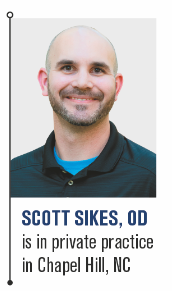Educate, don’t sell to patients


ODs must sell from the exam chair. Everyone has heard it, a lot of us have tried it, but how well does it actually work?
Do we as ODs have time to go through all lens options, discuss what makes a particular progressive lens better or worse, and delve into different anti-reflective options? Don’t even get me started on the multiple levels of blue light protection. It’s overwhelming, time consuming, and cumbersome
Speaking a foreign language
So, what’s the solution?
Recently, I have tried to educate patients in my discussions rather than mention specific brands, designs, or features.
For example, a previous conversation might finish with, “You are nearsighted with astigmatism, and you need extra help to see up close, so I recommend Brand XYZ progressive and this specific anti-reflective coating with blue light filter and/or photochromic lens.”
Previously by Dr. Sikes: Why my passion for pediatrics exams stays personal
Think about that from the patient’s perspective. In essence, the doctor just spoke a different language to you, and you are expected to make an informed decision based on one sentence of confusing proper nouns.
I remember a long time ago before current technology that I wanted to get a pager. I knew nothing about them and went into a Radio Shack store to ask questions and learn which one would best suit my needs.
When I asked the sales associate to tell me about the different pagers, he launched into a very rehearsed speech about this feature and design versus other technical specifics, network coverage, how messages are received but not sent, and on and on. At the end of his diatribe, I looked at him and asked, “And what does that mean to me?”
Many ODs and optical staff forget this key element: What does that mean to the patient?
We can throw out all the technical jargon, names, price points, percentages, everything we have been taught, but until we break it down and say why something is better or worse, it doesn’t mean anything at all to a patient.
Now, my conversations are just that, conversations-not lectures.
Having a conversation
During the exam, I present an option to the patient that I think will best suit his visual needs. However, in this initial discussion I do not mention brand names names.
When I discuss a progressive lens with the patient, I tell him that many different styles and types of progressives or no-line bifocals are available. I say the newest technology minimizes blur and distortion of vision on the sides, minimizes side-to-side head movement, and provides a wider computer and reading area.
Read more patient care articles
I mention progressives and no-line bifocals in the same breath to help minimize confusion; I find that more patients are familiar with the term “no-line bifocals.” Often, I need to explain the difference between progressives and photochromic lenses because many patients are confused by that terminology as well.
I also discuss the visual benefits of anti-reflective treatments for reducing eyestrain and fatigue, decreasing glare and halos around lights (especially while driving at night), and providing scratch protection for his glasses. At this point I mention a one- or two-year warranty against scratches depending on what level of protection he chooses.
Finally, if the patient expressed interest in photochromic lenses or reports prolific computer use, I discuss the potential benefits of photochromic lenses and/or blue filter products. I group these together because most photochromic lenses have inherent bluelight protection.
For patients who use electronic devices more than a few hours per day, I recommend some form of blue light protection to help protect their eyes from eyestrain and fatigue. Exposure to blue light can increase alertness and stimulate cognitive functions. Excessive blue light exposure especially right before sleep can disrupt sleep/wake cycles, so patients may not be getting full restful sleep, particularly if using electronic devices right before going to sleep.1
Research has not definitively determined if prolonged exposure to blue light can affect the macula and potentially increase risk of age-related macular degeneration (AMD) in patients-some research shows blue light as a factor while other data shows no signiicant relationship,1 but I continue advise my patients of that potential as well.
This is also a good opportunity to educate patients on the importance of sun protection. Glasses wearers often do not have prescription sunglasses. In addition, many of my contact lens wearers do not have sunglasses to wear over their contact lenses.
Related: How to recognize and manage digital eye strain
Educate during the exam
In my experience, patients seem to be more receptive, understanding, and knowledgeable about the products they receive when ODs skip confusing terminology and simply describe the product and how it will benefit their ocular health and vision.
After I have these discussions with my patients, I hand them off to our optical staff and tell the staffer what I have already discussed.
This serves two key purposes:
• It informs the patient that the doctor and staff are on the same page
• It should minimize the amount of time and discussion between the patient and the optical staff. Not to say that there won’t be more or new questions that come up, but the majority of the big questions should have been already answered
I know you are thinking, “Who has time to go through all of that at the end of the exam?” Probably no one, myself included.
I don’t set aside specific time at the end of the exam to review options. I learned that I can discuss topics during the exam itself and break the lengthy conversation into smaller, more manageable parts. This makes the discussion more time efficient for me and easier for the patient to understand.
I will discuss lens type (progressive, single vision, digital) immediately after refraction as I am setting up for the next part of the exam.
While I’m performing the slit lamp exam or dilated fundus exam, I discuss anti-reflective treatments and blue filters as they pertain to the health of the eye. They are easily associated with exam findings like cataracts, AMD, digital device use, etc.
Related: How to successfully perform a pediatric eye exam
At the conclusion of the exam, I have time for general questions only. If the patient wants to discuss specific products or finances, I turn the patient over to the optical staff for additional conversation.
I have discovered that when patients returns for their annual exam, they retained much of the knowledge that I offered the previous year. In fact, many patients specifically request features for their glasses without me having to discuss them. This allows me to educate them on advances in technology since their last exams as well as answer other questions.
I think ODs fall short in educating patients on advances in technology. Often, I see patients with no change in glasses prescription, but their glasses are two to three years old.
Think about that. How many people use technology on a daily basis that is multiple years old?
Related: Innovative mobile technology targets low vision
Consider cell phones. Manufacturers release new phones about once year with record-breaking sales, so clearly consumers don’t like old technology.
So, why do ODs look only at the prescription change without educating patients on advances in lens technology since their last glasses?
Wrapping up
In short, focus more on educating your patients and less on selling to them.
If you educate patients on why they need a certain product, they will better understand their own visual needs and how you, the doctor, can help meet those needs. They may also be more likely to support your practice.
References:
1. Tosini G, Ferguson I, Tsubota K. Effects of blue light on the circadian system and eye physiology. Mol Vis. 2016;22:61-72.

Newsletter
Want more insights like this? Subscribe to Optometry Times and get clinical pearls and practice tips delivered straight to your inbox.